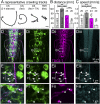Tyramine action on motoneuron excitability and adaptable tyramine/octopamine ratios adjust Drosophila locomotion to nutritional state
- PMID: 30808766
- PMCID: PMC6397572
- DOI: 10.1073/pnas.1813554116
Tyramine action on motoneuron excitability and adaptable tyramine/octopamine ratios adjust Drosophila locomotion to nutritional state
Abstract
Adrenergic signaling profoundly modulates animal behavior. For example, the invertebrate counterpart of norepinephrine, octopamine, and its biological precursor and functional antagonist, tyramine, adjust motor behavior to different nutritional states. In Drosophila larvae, food deprivation increases locomotor speed via octopamine-mediated structural plasticity of neuromuscular synapses, whereas tyramine reduces locomotor speed, but the underlying cellular and molecular mechanisms remain unknown. We show that tyramine is released into the CNS to reduce motoneuron intrinsic excitability and responses to excitatory cholinergic input, both by tyraminehonoka receptor activation and by downstream decrease of L-type calcium current. This central effect of tyramine on motoneurons is required for the adaptive reduction of locomotor activity after feeding. Similarly, peripheral octopamine action on motoneurons has been reported to be required for increasing locomotion upon starvation. We further show that the level of tyramine-β-hydroxylase (TBH), the enzyme that converts tyramine into octopamine in aminergic neurons, is increased by food deprivation, thus selecting between antagonistic amine actions on motoneurons. Therefore, octopamine and tyramine provide global but distinctly different mechanisms to regulate motoneuron excitability and behavioral plasticity, and their antagonistic actions are balanced within a dynamic range by nutritional effects on TBH.
Keywords: Dmca1D; biogenic amine; calcium channel; insect; neuromodulation.
Conflict of interest statement
The authors declare no conflict of interest.
Figures




Similar articles
-
Tyramine and octopamine have opposite effects on the locomotion of Drosophila larvae.J Neurobiol. 2004 Mar;58(4):425-41. doi: 10.1002/neu.10298. J Neurobiol. 2004. PMID: 14978721
-
The role of octopamine and tyramine in Drosophila larval locomotion.J Comp Neurol. 2012 Nov 1;520(16):3764-85. doi: 10.1002/cne.23152. J Comp Neurol. 2012. PMID: 22627970
-
Sensitivity to expression levels underlies differential dominance of a putative null allele of the Drosophila tβh gene in behavioral phenotypes.PLoS Biol. 2021 May 10;19(5):e3001228. doi: 10.1371/journal.pbio.3001228. eCollection 2021 May. PLoS Biol. 2021. PMID: 33970909 Free PMC article.
-
Linking physiological processes and feeding behaviors by octopamine.Curr Opin Insect Sci. 2019 Dec;36:125-130. doi: 10.1016/j.cois.2019.09.002. Epub 2019 Sep 14. Curr Opin Insect Sci. 2019. PMID: 31606580 Review.
-
Tyramine and octopamine: antagonistic modulators of behavior and metabolism.Arch Insect Biochem Physiol. 2003 Sep;54(1):1-13. doi: 10.1002/arch.10102. Arch Insect Biochem Physiol. 2003. PMID: 12942511 Review.
Cited by
-
One-pot H/D exchange and low-coordinated iron electrocatalyzed deuteration of nitriles in D2O to α,β-deuterio aryl ethylamines.Nat Commun. 2022 Oct 10;13(1):5951. doi: 10.1038/s41467-022-33779-8. Nat Commun. 2022. PMID: 36216818 Free PMC article.
-
PaOctβ2R: Identification and Functional Characterization of an Octopamine Receptor Activating Adenylyl Cyclase Activity in the American Cockroach Periplaneta americana.Int J Mol Sci. 2022 Jan 31;23(3):1677. doi: 10.3390/ijms23031677. Int J Mol Sci. 2022. PMID: 35163598 Free PMC article.
-
Regulation of growth in Drosophila melanogaster: the roles of mitochondrial metabolism.J Biochem. 2020 Mar 1;167(3):267-277. doi: 10.1093/jb/mvaa002. J Biochem. 2020. PMID: 31926002 Free PMC article. Review.
-
Synchronous multi-segmental activity between metachronal waves controls locomotion speed in Drosophila larvae.Elife. 2023 Aug 8;12:e83328. doi: 10.7554/eLife.83328. Elife. 2023. PMID: 37551094 Free PMC article.
-
Transcriptome Analysis of NPFR Neurons Reveals a Connection Between Proteome Diversity and Social Behavior.Front Behav Neurosci. 2021 Mar 31;15:628662. doi: 10.3389/fnbeh.2021.628662. eCollection 2021. Front Behav Neurosci. 2021. PMID: 33867948 Free PMC article.
References
-
- Marder E, O’Leary T, Shruti S. Neuromodulation of circuits with variable parameters: Single neurons and small circuits reveal principles of state-dependent and robust neuromodulation. Annu Rev Neurosci. 2014;37:329–346. - PubMed
-
- Roeder T. Tyramine and octopamine: Ruling behavior and metabolism. Annu Rev Entomol. 2005;50:447–477. - PubMed
-
- Verlinden H, et al. The role of octopamine in locusts and other arthropods. J Insect Physiol. 2010;56:854–867. - PubMed
Publication types
MeSH terms
Substances
LinkOut - more resources
Full Text Sources
Molecular Biology Databases

